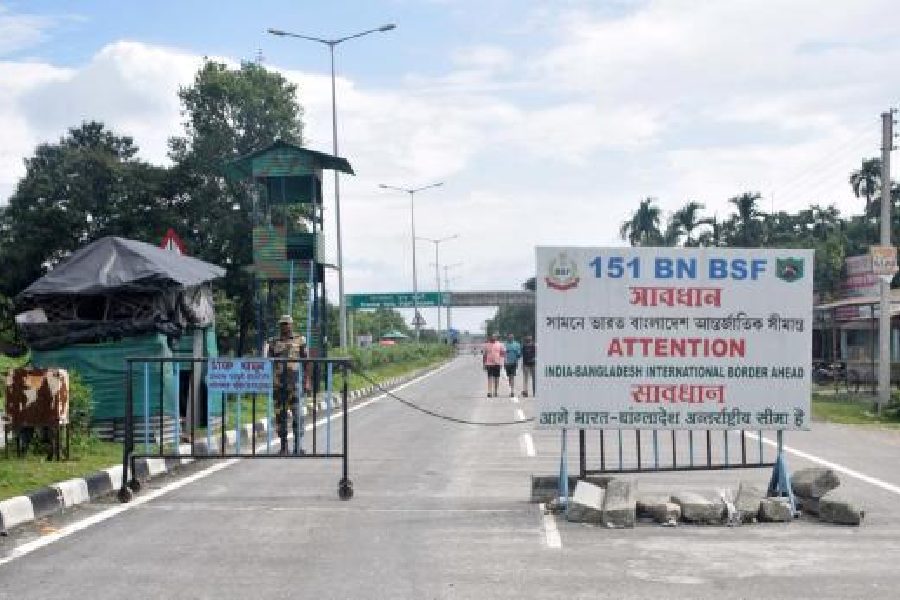It’s early days in deeply troubled Bangladesh where violence appears to be ebbing as Nobel laureate Muhammad Yunus prepared to take office and head an interim government. One will have to wait and observe with patience how Dr Yunus will handle the delicate and volatile situation in the wake of Sheikh Hasina Wazed’s ouster and the riots that followed.
Sheikh Hasina, Bangladesh’s longest serving Premier who held power and ruled towards the end of her term, increasingly with an iron fist, impervious to and intolerant of dissent.
As the air now hots up with conspiracy theories about her overthrow, a tumult of political change has surged across the country with reports of organised and mob attacks on Awami League leaders, cadres and offices, Hindus and institutions and the surge of the Jamaat.
However, many eyes especially from the Northeast, will be on two issues.
The first being the 4,096 km border with Bangladesh of which the North Eastern Region (NER) has a share of 1,879 km. The rest is with West Bengal. Borders are important because the anxiety on the Indian side, especially in the small Northeastern states, is about the possible ingress of large numbers of Bangladeshis especially Hindus and supporters and panicked members of ousted Prime Minister Sheikh Hasina Wazed’s Awami League, who have been facing attacks. Geography dictates history, politics and economy. Northeast India is landlocked with borders with Bangladesh, Bhutan, China and Myanmar.
Bangladesh is hemmed in by India. for the most part with a small connect to Myanmar and girded to the south by the Bay of Bengal.
The Border Security Force (BSF) has been mobilised and placed on high alert with clear instructions issued to stop people from crossing the border — which is anyway difficult because two third of it has already been fenced. In addition, Meghalaya has put a night curfew along its border with the neighbouring country.
In Mizoram, one district has restricted the movement of people between 6 pm and 6 am within 3 km of the borders while Tripura announced the closure of its international boundary with Bangladesh.
Four Northeastern states have borders with Bangladesh, the longest being Meghalaya with 856 km, Mizoram (318 km) and Tripura (443 km). These are tiny states with small populations when compared to larger Indian states such as West Bengal or Bihar and local concern about pressure on demographics is natural. Assam, which is the largest state and where the largest, longest, loudest and sharpest protests have taken place over decades about alleged illegal migration from Bangladesh, has the smallest segment of the international border: 262 km. Patricia Mukhim, editor of The Shillong Times, the largest English-language newspaper in Meghalaya, says that she is concerned about migration, both formal and informal.
Mukhim noted that the state education minister was already talking about allowing “indigenous people” into the state — members of the Garo and Khasi tribes also live in Bangladesh — on compassionate grounds. This, she added, could have “unintended consequences”. In a state with high unemployment and scarce resources.
Assam chief minister Himanta Biswa Sarma underscored the issue of irregular migration from Bangladesh, which has long vexed the region especially Assam: “If unrest persists in Bangladesh people will attempt to come to India, we must secure the border,” he said.
In addition, political leaders, security officials and analysts are concerned about a second issue: the return of the anti-India rebels who had made Bangladesh their base for long years and used it for attacks, money mobilisation and as a propaganda base.
That was before Sheikh Hasina cracked down on them, dismantled their networks and handed over leaders like the chairman of the United Liberation Front of Asom, Arabinda Rajkhowa, to India.
Chief minister Sarma told reporters that the potential reorganising by discredited rebel groups from the state and region was a matter of anxiety and he hoped that
that the new government of Bangladesh and the government of India would “address the concern of Northeast India”.
A senior security analyst said that while investments in infrastructure and transit projects may be on hold for some time before resuming, the matter of “safe sanctuary” for rebel leaders, some of whom had been based there in the pre-Awami League period, would be a key test for the new government.
Pradyut Dev-Burman, scion of the former royal family of Tripura whose Tripura Motha party has a partnership with the BJP, said that the situation would adversely impact the Northeast if it enabled the possible regrouping by Northeastern insurgent groups and the continuing rise of the Right-wing Jamaat-i-Islami.
But for now, all of us need to wait and watch as the situation unfolds and wish Bangladesh well as Yunus, its pre-eminent economist and citizen, seeks to bring stability and peace with his disparate team.
Building the architecture of a secure neighbourhood means patient partnership and mutual respect. We can change many things including spouses but not our neighbours.











